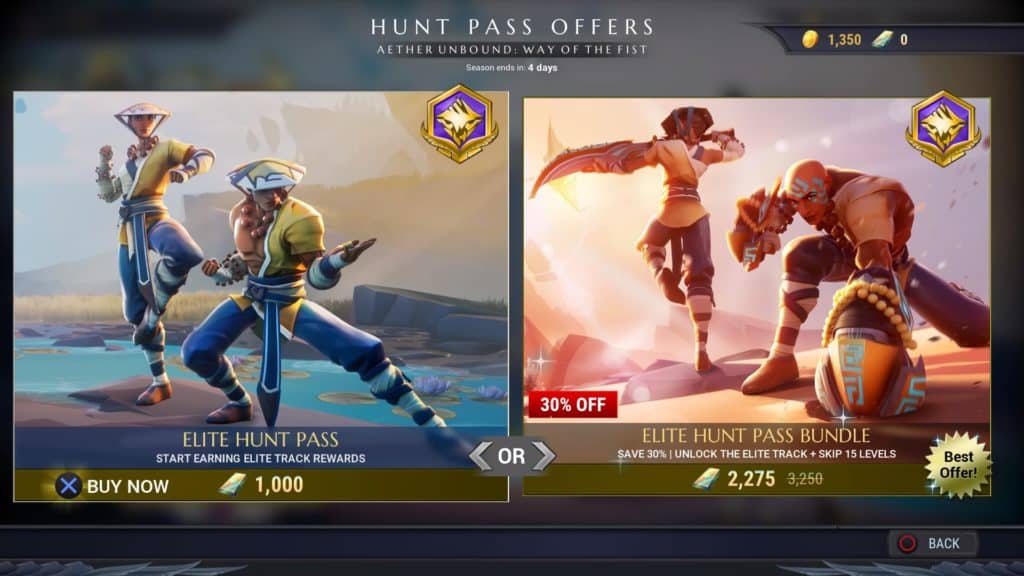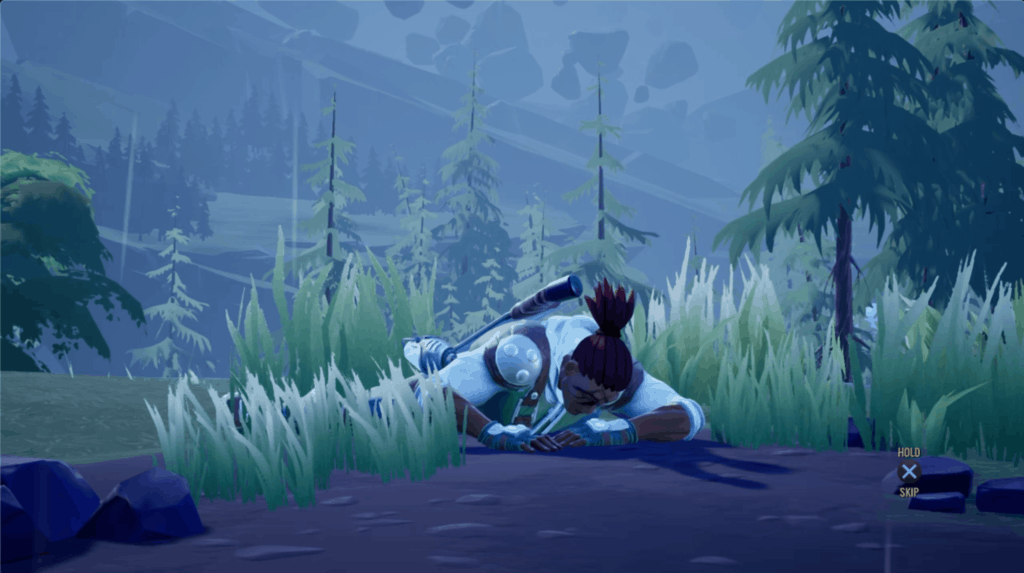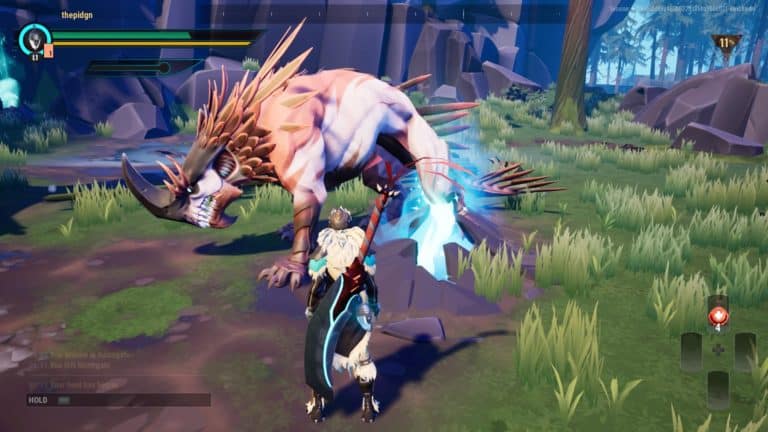Here at Co-op Gaming Dot Info, we usually review games we’ve relentlessly played for months. For a game to keep our attention every night, it’s usually awesome. We wanted to give more coverage to games that we tried and decided not to play—games that didn’t give us a moment’s hesitation when we uninstalled them to make space for more exciting downloads. This column won’t provide an in-depth look at each game we uninstalled; we didn’t play them long enough to reach end-game or form strong opinions about their combat, storyline, or systems. We want to merely list the reasons why the game turned us off, whether it took a couple hours or a couple days of playtime. The game we most recently uninstalled? Dauntless.
When you hear about a game called ‘Dauntless’, what comes to mind? I expected an RPG adventure in which a courageous knight ventures onto an enormous battlefield and defeats tough warriors. Imagine my surprise when I learned Dauntless is, in fact, a monster-killing game. I suppose the word ‘dauntless’ has no direct connotation; it’s just a word associated with bravery. Something like, “Monster Hunter” would have been more descriptive, but that name was already taken. The creators of Dauntless couldn’t muster up anything creative or captivating to describe their game, so they visited the thesaurus, found a synonym, and said it would do. The meaningless title feels like part of the grand experiment of Dauntless: knock off a AAA title, make it free-to-play, litter it with in-your-face microtransactions, make it cross-platform, and see how much money can be made.
The first time we booted up Dauntless, shortly after it was released on PS4, the queuing process, wait times between matches, and load-screen sequences were long, complicated, and mystifying. When we turned on Dauntless last weekend, that issue had been resolved. We were able to hop between Ramsgate, the home base, and any given hunt quickly and easily. Clearly the dev team and its corporate complex have been improving this game, and there’s definitely a tremendous amount of thought and effort behind the game’s combat and systems as a whole. Playing it for a second time, though, we hated it even more than at first. John even said that if he were trapped in a well and had Dauntless on his phone, he’d rather play Angry Birds.
1. Dauntless Is Like Monster Hunter, Minus Any Happy Creativity or Eccentricity
Our first complaint has been echoed by gamers everywhere since Dauntless’ release—the game feels like generic-brand Monster Hunter: World. The opening cinematic, featuring a group of novice adventurers and a shipwreck, seems as if MH:W was used as a storyboard, and then MH:W’s identifying characteristics—such as the Palico companion, plates of giant meat, and, of course, the Elder Dragon—were edited out. As you venture into The Shattered Isles (the Dauntless world) and defeat your first behemoth, you find more similarities to MH:W. Both games consist of using melee weapons in triangle-square combos to kill enormous beasts. Gear bonuses, as well as the system of crafting gear from harvested monster body parts, are similar. Dauntless’ selection of melee weapons isn’t quite identical to MH:W’s—it doesn’t include anything as strange, inventive, and immediately intriguing as the insect glaive and hunting horn.
Once you start comparing Dauntless to MH:W, you start remembering all the things that made you smile the first time you played MH:W. Finding a rare gathering node that was intricately integrated into the beautifully detailed map. The first time you performed enough aerial combos to mount the monster, and you rode him through the sky and desperately mashed buttons to keep from falling off. The way you’d beat the MH:W monsters into drooling, exhausted, broken animals, and they’d drag themselves to their den to die. The adorable animation of your character ripping into the monster’s corpse to loot it after a fight.
Nothing you experience in the first hour of playing Dauntless will surprise or delight you like those MH:W moments. In Dauntless, monster-killing is a rather joyless chore. The monsters are practically penned up, presenting themselves for slaughter moments after you drop into a map. Gathering is clicking “X” on a plant. I’m not going to enumerate every creative flourish, smart system, or the satisfying dynamics that makes MH:W a better game than Dauntless. There are thousands of comparisons online already.
The problem with Dauntless is that it doesn’t distinguish itself from MH:W. It does nothing to make players who love MH:W choose Dauntless instead (or in addition). Dauntless could have been open-world; it could have included some kind of PvP mode; it could have had a unique build system or movement mechanics; it could have trumped up and clarified things that do make it different, such as the “threat level” mechanic, whatever that is. The fact that the two games share the same core gameplay didn’t automatically mean one game had to be more fun. Hundreds of fantasy games, such as World of Warcraft and Elder Scrolls Online, have similar gameplay, but that doesn’t make them feel like clones. Probably Dauntless never wanted to get players’ minds off MH:W. That’s what a knock-off is—a cheaper (in this case, free-to-play) substitute for a beloved name-brand product.
2. Dauntless’ Opening Is Soft—Too Soft
Despite the palpable lack of inspiration at Dauntless’ core, the combat seems like it should be fun. Examining the weapon move sets, we clearly saw the potential for mastery, artistry, and rich, high-level play in this game. So why is launching a perfect angry bird in Angry Birds absolutely more exciting than taking down your first behemoth in Dauntless? While puzzling over this question, I remembered a passage I recently read in Getting Gamers: The Psychology of Video Games by Jamie Madigan. In the chapter I’m quoting, he talks about the Dunning-Kruger effect in video games, but I think he illustrates an important point about the “fun-factor” of trying a new game.
“ . . . games often allow you to be incompetent in the pursuit of fun and stroke your ego with [positive feedback]. New players can soak up bullets in some shooters, such as Gears of War, instead of using cover effectively or choosing the right weapon for the situation. They can brute-force their way through a campaign scenario in Starcraft II using just cheap Marine units instead of appropriately countering the enemy’s army built with advanced units . . . In each case, these players are essentially incompetent, but the limited feedback they’re getting doesn’t allow them to know it. The novice bumbles along missing all that but getting the occasional lucky shot and thinks he’s doing all right for himself. . .
“Some game developers are learning to address this paradox by forcing novice players to learn the true scope of the game . . . Many fighting games like the newer entries in the Street Fighter series also have special training modes that illustrate enigmatic concepts, such as hit boxes and frame data. This kind of tutorial helps, as do collecting and presenting community guides and videos illustrating everything a game has to offer.”
The key words here are “forcing novice players to learn the true scope of the game.” When experienced gamers turn on a game for the first time, they’re not looking to be rewarded for incompetence. Ego stroking on low difficulty can equal boring. There’s got to be something in that first hour of play that challenges us, makes us want to get good at the game, or makes us dream of the end-game. We want something that illustrates the game’s “true scope”—and how far away we, the newbies, are from it.
When Dauntless is compared online to Monster Hunter, you’ll often seen it described as more “accessible,” a.k.a. easier. And let me tell you, those first hunts, with four players in each instance, were stupid easy. The wild dogs in Far Cry New Dawn are far more vicious, brutal, and deadly than Dauntless’ first big fat behemoth. It actually felt absurd to gather a group of bros, four total real-life adults, to complete something as simple as defeating that behemoth. Perhaps Dauntless is designed for children, but four children working on a word-search puzzle would have a bigger challenge ahead of them.
In the summary screen, Dauntless lets you know how fast and easy the kill should have been—defeating the behemoth in five minutes or less gives you a better rank. Two, three, or four minutes or less nets an even better score. The very concept of asking four humans to complete a task that takes roughly four minutes is probably goofed. Would you ask three people to help you make coffee?
I believe that the Dauntless creators attempted to introduce new players to the scope of the game early on by giving us a new weapon, the Aether Strikers, along with a quest to successfully perform its combos. This is no easy feat, and attempting to complete the quest successfully illustrates the nuances and challenges of executing the game’s combos. But it doesn’t spark joy.
The second time we tried Dauntless, we limited the instance to just the two of us rather than queueing with group of four. We had to hit more buttons, but there was still nothing intriguing about it, nothing that made us excited to play more.
All I can think is, we want danger! I’m reminded of two other games we’ve recently played. We played Anthem for three days, and during that time, we never once died in the game. In fact, neither of us even figured out which of the bars on the screen displayed our health. There was no need, and that was terrible game design. Dauntless wasn’t that bad; when we took a hard blow, we immediately noted its negative effect on our health and healed up. We also managed to die after advancing as quickly as we could without crafting new gear.
Then I’m reminded of Far Cry. When we tried Far Cry 5 last year, I was such a trashy player that I couldn’t make it past the intro. I died repeatedly! John had to complete the intro for me! It was frustrating! It made me hate the game! A year later we tried Far Cry 5 again. We played through on normal difficulty and loved the game, but it wasn’t nearly as difficult as we’d grown accustomed to playing in Tier Mode in Ghost Recon: Wildlands. We decided to play the newer Far Cry, Far Cry New Dawn, on “Hard-Ass” difficulty.
The New Dawn intro has you emerge from some kind of train crash. You have no weapon—just your fists. Players must loot a weapon or take down an enemy and take his weapon; then they must escort some NPCs and make it to an extraction point. All the while, a veritable zerg of enemies swarms the wreckage, coming in and out of cover and constantly discovering the player’s location. Here is the intro from Ubi’s official “First Twelve Minutes” vid:

This was a tough intro, especially on hard-ass difficulty. This time I succeeded, and John failed—more than once! If you watched until the end of that video, you would have seen that even the Ubisoft demonstration player did not take out every enemy. Due to my cautious nature and desire not to pathetically fail a Far Cry intro again, I focused more on getting to the objective, remaining undiscovered, and only killing enemies who were in my way.
What’s my point here, other than this cool brag? Now that we’re much deeper into New Dawn, I see that the intro successfully emulated the gameplay when you’re trying to reach the extraction point in a three- or four-star difficulty expedition. When the package GPS goes off, the entire enemy camp is alerted to your presence. Every man and woman leaves their post and chases you like that package is worth ten million bucks. ATVs and cars full of reinforcements race to your location on every roadway. Rocket-launcher guys come crawling out of the meadows. You’ve got to keep your eyes on that extraction point and book it to make it out alive.
There’s a lot to unpack here. The New Dawn intro gameplay successfully illustrates the scope of the game by merely showing some of the challenges the end game offers. It didn’t demand new players somehow expertly kill those threatening, rowdy enemies—it just demonstrated what it’s going to be like when they’re all on you like flies on shit. Simply put, I think we probably would have been more excited about Dauntless even if we just had to run past some legendary behemoths, dodging their attacks or being slaughtered by them, on the way to our pathetic first behemoth. Of course Monster Hunter: World includes this kind of danger: there’s always a chance you’ll encounter a powerful, armored, poison-spewing high-level dragon when you’re out hunting a lizard.
I know what it’s like to turn on a game you’re excited to play and face bitter defeat instead of an ego-stroking easy victory, and I know that can turn players off and prevent them from diving into the game and getting all the joy the game has to offer. At the same time, I had never played video games in my life. Dauntless will be coming to mobile, so perhaps the game is targeted at that “never played games before” market, and children. But that just makes Angry Birds look like more fun.
3. Dauntless’ Microtransactions Almost Had More Screen Time Than the Behemoths
From the moment you set foot in The Shattered Isles, Dauntless wants you to pay. We were made excruciatingly aware of the Elite Hunt Pass—you gain more experience, bonus loot, and, best of all, skip 15 levels—long before we’d learned how to complete a combo with our newly chosen weapons. One of our first quests was to pick up some free dyes in the store, training us to make purchases. Nearly every time we returned from a hunt, a microtransaction ad was displayed, like a pop-up we had to close to continue playing.

“Normal microtransactions work as positive reinforcement. Pay some money, get a thing you wanted.” That’s what Forbes writer Paul Tassi said in an old article about time-gating in video games. It’s a simple statement, but it reveals the problem that Dauntless’ microtransactions presented to us as new players. We weren’t given enough time to want anything in the game. We weren’t even given enough time to understand what types of things we could want. Turning on Dauntless was like trying to do Convict Conditioning for the first time in the park, and then having ten personal trainers crowd around you, presenting you with resistance bands, herbal supplements, and twist boards.
We were tipped off to some of Dauntless’ nastier phone-game/time-gating aspects when we saw something like free-standing ashtrays scattered around Ramsgate—these contained a globe of light, ten of which could be collected per day. A quick Google search reveals Dauntless players on Reddit complaining about time-gated trials and weapon unlocks. We’re never going to play Dauntless enough to understand the specifics of those players’ complaints or what kinds of sign-in-every-day-or-miss-out suffering awaited us at the higher levels, and we’re glad we won’t.
We don’t play a ton of free or mobile games, so we can’t say Dauntless’ practices are out-of-line. But we can speak to the experience of playing Path of Exile, another free game. We played Path of Exile for several months and gave Grinding Gear Games not a dime of our hard-earned dimes. Other than notifying us when there was an occasional sale in the store, Grinding Gear never pushed us over to their cash register. We had a great time. We became fond of the game. We even fell in love with the game. And when we’d played long to be annoyed at organizing our items and currency, we headed over to the store and bought our first stash tabs, bundles, and dee-daws. We felt good getting something that would enhance something that already felt good. When were we supposed to feel good about spending in Dauntless?
4. Dauntless Is the “Basic Bitch” of Unreal Engine
Aesthetically, Dauntless is plainest, most homely Unreal Engine game we’ve played. You could say it looks like an improvement on the “posterize” filter in Photoshop. It certainly doesn’t look bad, but if it were a Tinder profile, we wouldn’t swipe right.

Remnant: From the Ashes looks lovely by comparison. Naruto To Boruto Shinobi Striker is a veritable Unreal Engine artistic masterpiece. Fortnite and Borderlands obviously look better. Heck, John even played that Game of Thrones game for a second, and to my memory, that had more visual appeal than Dauntless. Neither of us demands that a game we play seems beautiful or worthy of taking those corny in-game screenshots. The lack of detail in the Dauntless world is just another thing that made us feel like the game doesn’t care if we like it. It just wants us to consider it, as you would the box of Toasty-Os next to the Cheerios.






